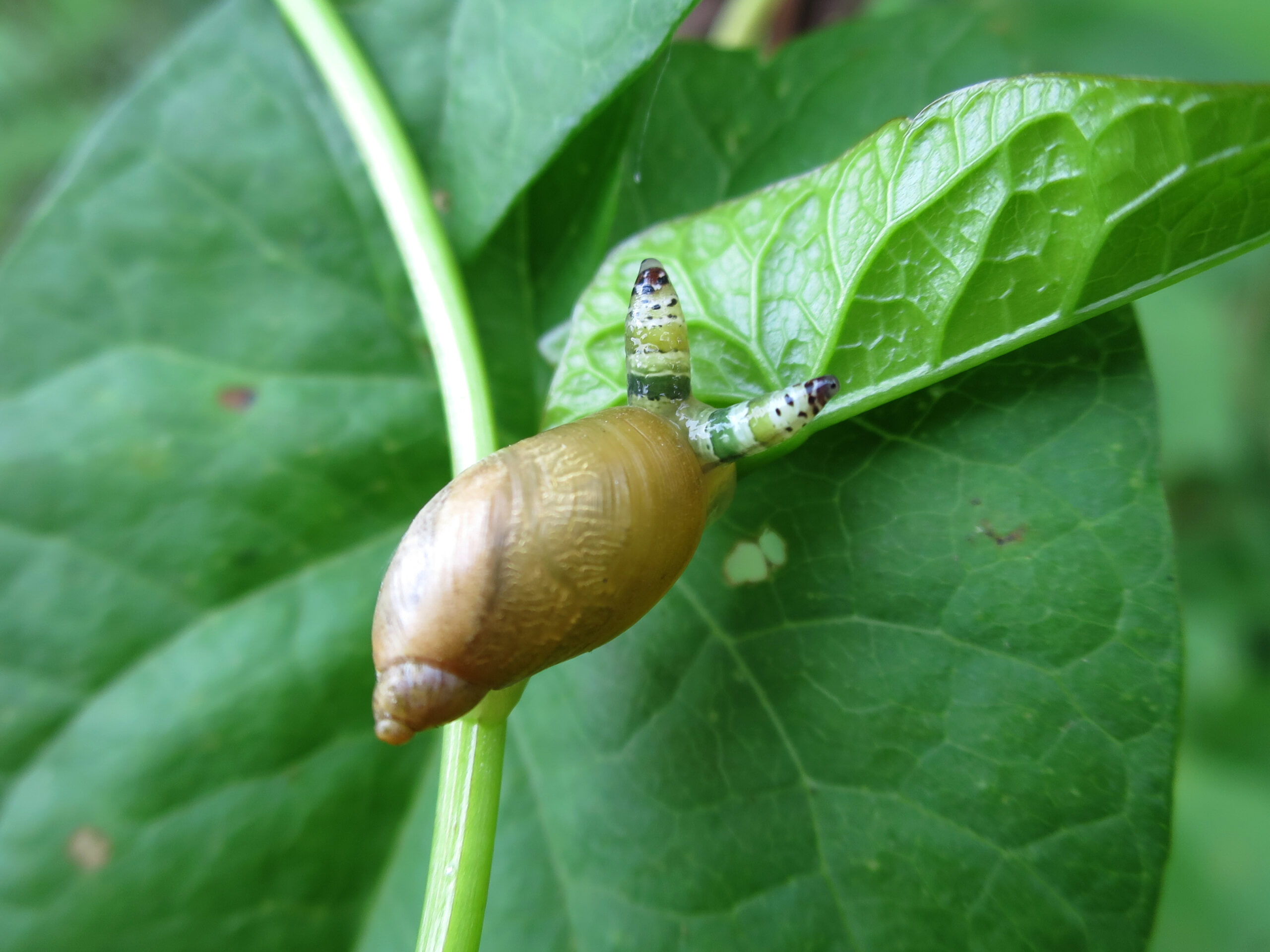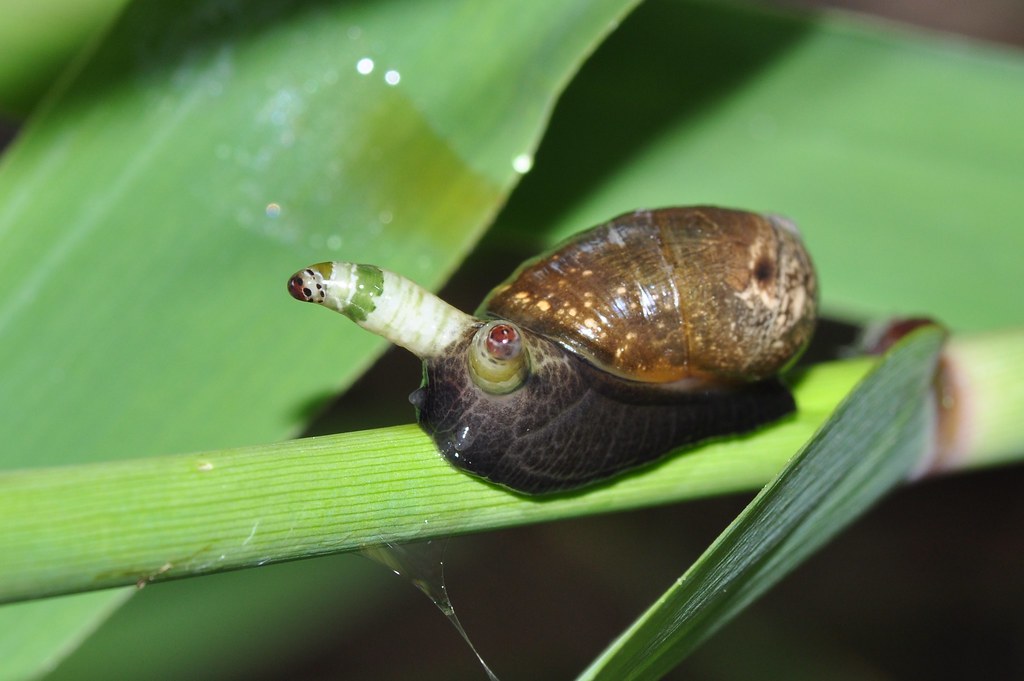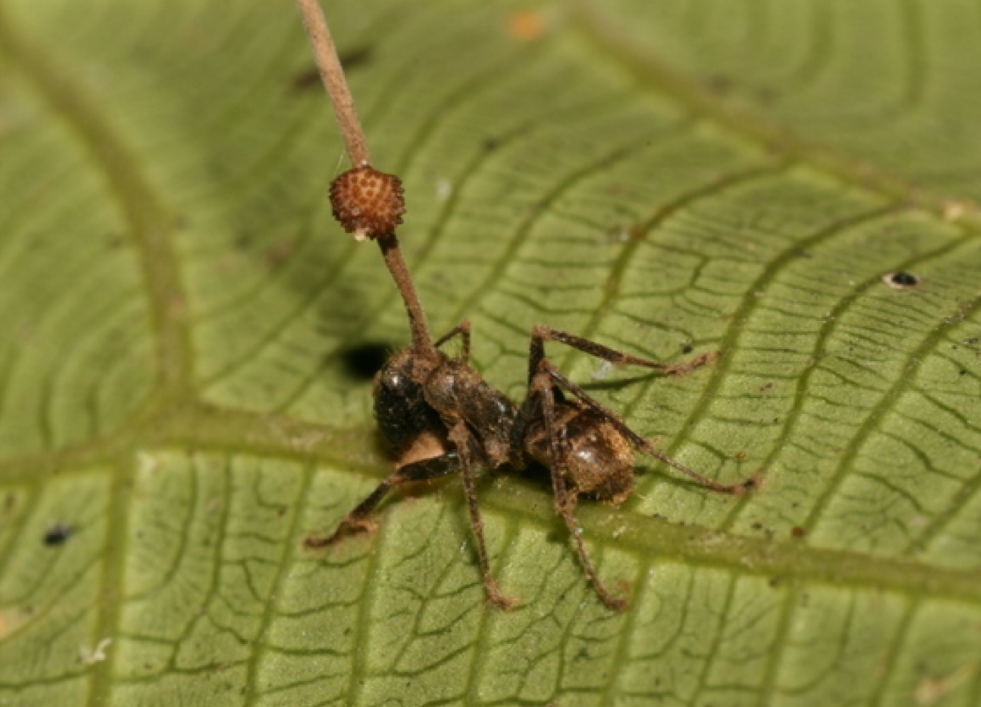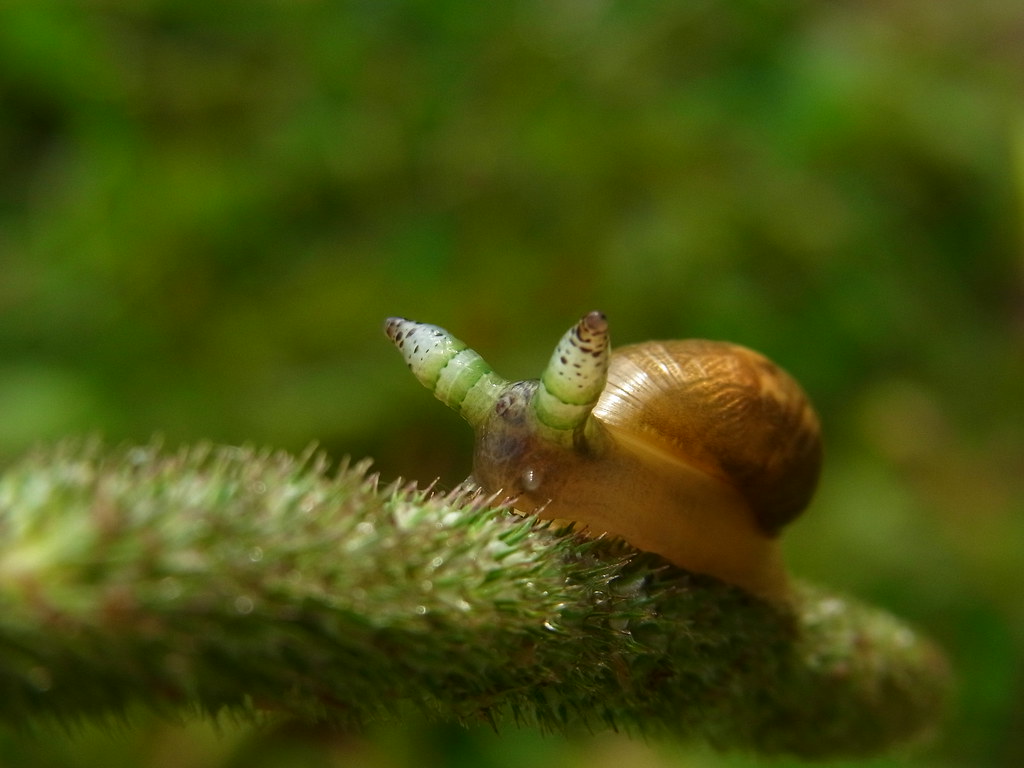Picture this: you’re walking through a peaceful meadow when you spot a snail behaving strangely. Its eyestalks are pulsing with vibrant, rainbow-colored bands that seem almost hypnotic. The snail moves awkwardly, seeking out the brightest spots it can find, as if it’s desperately trying to be noticed. What you’re witnessing isn’t some bizarre snail dance party—it’s one of nature’s most sinister puppet shows. Inside that innocent-looking mollusk lurks a parasitic flatworm that has completely hijacked its host’s body and mind, turning it into a living beacon designed to attract hungry birds. This isn’t science fiction; it’s the terrifying reality of Leucochloridium paradoxum, a microscopic mastermind that orchestrates one of the most elaborate biological conspiracies on Earth.
Meet the Master Manipulator Behind the Madness

Leucochloridium paradoxum isn’t your typical flatworm—it’s a parasitic genius that has evolved over millions of years to perfect the art of mind control. This microscopic puppet master belongs to a group of parasites called trematodes, and it’s specifically designed to exploit one of nature’s most basic relationships: predator and prey. The flatworm’s entire existence revolves around a single, chilling objective: transforming innocent snails into irresistible targets for hungry birds. What makes this parasite particularly fascinating is its incredible specificity—it doesn’t just randomly infect any creature it encounters. Instead, it has co-evolved with particular snail species, developing an almost intimate knowledge of how to manipulate their biology. The scientific community has been studying this remarkable organism for decades, yet new discoveries about its capabilities continue to emerge, revealing just how sophisticated this tiny terrorist really is.
The Sinister Journey from Bird to Snail

The horror story begins innocently enough when a bird—typically a songbird like a robin or finch—drops its feces containing microscopic flatworm eggs onto the forest floor. These hardy eggs can survive harsh environmental conditions for weeks, patiently waiting for the perfect moment to begin their invasion. When an unsuspecting snail encounters this contaminated material while foraging for food, it inadvertently ingests the parasite eggs along with decomposing organic matter. The moment those eggs enter the snail’s digestive system, they begin their transformation into one of nature’s most effective biological weapons. What happens next is like something out of a horror movie: the eggs hatch into larvae that immediately begin their journey through the snail’s body, seeking out the perfect location to establish their command center. This initial infection process is so subtle that the snail continues its normal activities, completely unaware that its fate has been sealed.
Establishing the Command Center Inside the Host

Once inside the snail’s body, the flatworm larvae embark on a remarkable journey of growth and development that would make any military strategist jealous. They migrate through the snail’s tissues, eventually settling in the eyestalks—those tender, elongated structures that house the snail’s primitive eyes. Here, the parasites undergo a dramatic transformation, growing into colorful, pulsating structures called sporocysts that look nothing like typical worms. These sporocysts are essentially living factories, designed to produce thousands of reproductive cells while simultaneously taking control of their host’s nervous system. The parasites don’t just occupy the eyestalks; they become the eyestalks, replacing normal tissue with their own specialized organs. This incredible feat of biological engineering allows them to control both the snail’s visual system and its behavior patterns. The transformation is so complete that the infected eyestalks become virtually indistinguishable from the parasite itself.
The Hypnotic Light Show That Spells Doom

The most visually stunning aspect of this parasitic takeover is the incredible light show that the infected snail begins to display. The parasite-filled eyestalks pulse with brilliant bands of green, orange, and yellow that move in rhythmic waves, creating a mesmerizing pattern that’s impossible to ignore. These aren’t just random colors—they’re carefully orchestrated visual signals designed to mimic one of a bird’s favorite foods: plump, juicy caterpillars. The pulsating motion perfectly imitates the way caterpillars move when they’re feeding, creating an irresistible lure for hungry birds scanning the landscape for their next meal. What makes this display even more remarkable is its timing; the parasite somehow knows when conditions are optimal for attracting avian predators. The light show intensifies during peak feeding hours when birds are most actively hunting, demonstrating a level of environmental awareness that seems almost supernatural. This living neon sign transforms the once-camouflaged snail into the most conspicuous creature in its habitat.
Mind Control Tactics That Defy Belief

The flatworm’s manipulation extends far beyond creating flashy visual displays—it literally rewrites the snail’s behavioral programming to serve its own sinister purposes. Healthy snails are naturally secretive creatures that prefer dark, moist hiding places where they can avoid predators and harsh sunlight. However, once infected, these same snails abandon their survival instincts entirely and begin seeking out the brightest, most exposed locations they can find. The parasite somehow overrides millions of years of evolutionary programming, forcing its host to climb to the tops of plants and position itself in direct sunlight where birds can easily spot it. Even more disturbing is how the infected snail loses its natural fear response—it no longer recoils when shadows pass overhead or when potential threats approach. This behavioral transformation is so complete that infected snails essentially become willing participants in their own destruction. Scientists are still trying to understand exactly how the parasite achieves such comprehensive control over its host’s nervous system.
The Perfect Timing of a Biological Clock

One of the most sophisticated aspects of this parasitic manipulation is the incredible precision with which it occurs. The flatworm doesn’t just randomly activate its light show—it operates on a biological schedule that perfectly aligns with the feeding patterns of its target bird species. During the early morning hours when songbirds are most actively foraging, the infected snail’s eyestalks begin their hypnotic pulsing display. As the day progresses and bird activity decreases, the parasite dims its beacon and allows the snail to retreat to safer locations. This cyclical pattern demonstrates that the parasite has somehow tapped into both its host’s circadian rhythms and the broader ecosystem’s daily patterns. The timing is so precise that researchers can actually predict when infected snails will begin their zombie-like performances. This level of environmental synchronization suggests that the parasite has evolved mechanisms for detecting and responding to subtle environmental cues that even scientists are still trying to identify.
When Birds Become Unwitting Accomplices

The moment a bird spots the pulsating, caterpillar-like eyestalks of an infected snail, the final act of this biological drama begins to unfold. The unsuspecting bird swoops down and pecks at what it believes to be a delicious caterpillar, inadvertently consuming the parasite-filled eyestalks along with its intended meal. Remarkably, the snail often survives this violent encounter, though it’s left permanently blind and traumatized by the experience. Inside the bird’s digestive system, the consumed parasites finally reach their ultimate destination—the perfect environment for sexual reproduction and egg production. The flatworms mature rapidly within the bird’s intestines, mating and producing thousands of eggs that will eventually be deposited back into the environment through the bird’s droppings. This completes the parasite’s incredible life cycle, ensuring that the next generation of mind-controlling flatworms will be ready to begin the process all over again. The bird, completely unaware of its role in this elaborate scheme, simply flies away to continue its normal activities.
The Snail’s Tragic Fate After the Attack

While the parasite achieves its reproductive goals, the aftermath for the infected snail is nothing short of tragic. After losing its eyestalks to a hungry bird, the snail is left completely blind and unable to navigate its environment effectively. These once-agile creatures become stumbling shadows of their former selves, bumping into obstacles and struggling to find food or shelter. The most heartbreaking aspect is that many snails can actually regenerate their lost eyestalks over time, but this recovery process leaves them vulnerable to reinfection by the same parasite species. Some unlucky individuals become trapped in a horrific cycle, repeatedly growing new eyestalks only to have them consumed again by the next generation of parasites. Despite these overwhelming challenges, some infected snails do manage to survive and even reproduce, though their quality of life is permanently diminished. The resilience these creatures display in the face of such biological warfare is both inspiring and deeply sobering.
Scientific Breakthroughs in Parasite Research

The study of Leucochloridium paradoxum has opened up entirely new fields of scientific research, particularly in the areas of behavioral manipulation and neural control. Researchers have discovered that the parasite produces specific chemical compounds that interfere with the snail’s neurotransmitter systems, essentially hijacking the communication pathways within the host’s nervous system. Advanced imaging techniques have revealed the intricate ways in which the parasite integrates itself into the snail’s neural networks, creating new pathways while blocking others. These findings have significant implications for understanding how parasites in general might influence host behavior, including those that affect humans. Scientists are now investigating whether similar mechanisms might be at work in other host-parasite relationships, potentially revolutionizing our understanding of behavioral disorders and mental health conditions. The research has also contributed to the development of new treatments for parasitic infections, as understanding the parasite’s control mechanisms helps researchers identify potential intervention points.
Other Mind-Control Masters in the Animal Kingdom

Leucochloridium paradoxum isn’t alone in its ability to manipulate host behavior—the natural world is filled with other equally impressive examples of parasitic mind control. The zombie ant fungus (Ophiocordyceps unilateralis) forces infected ants to climb to specific heights before clamping down on leaves with their mandibles, creating the perfect launching pad for fungal spores. Toxoplasma gondii, a parasite that affects rodents, makes infected mice and rats lose their natural fear of cats, increasing the likelihood that they’ll be eaten by the parasite’s preferred final host. The emerald jewel wasp performs neurosurgery on cockroaches, injecting venom directly into specific brain regions to create docile zombie roaches that willingly walk into the wasp’s burrow. These examples demonstrate that behavioral manipulation by parasites is far more common than most people realize, representing a fundamental strategy that has evolved independently countless times. The diversity of these mind-control techniques suggests that the ability to manipulate host behavior provides such significant evolutionary advantages that it’s worth the incredible biological investment required to develop these capabilities.
The Evolutionary Arms Race Between Predator and Prey

The relationship between Leucochloridium paradoxum and its hosts represents one of nature’s most intense evolutionary arms races, with each species constantly developing new strategies to outwit the other. Over millions of years, the parasite has refined its manipulation techniques, developing increasingly sophisticated methods for controlling snail behavior and attracting bird predators. Meanwhile, snails have evolved various defense mechanisms, including improved immune responses and behavioral adaptations that help them avoid infection in the first place. Some snail populations have developed the ability to detect and avoid areas contaminated with parasite eggs, while others have evolved thicker eyestalk tissues that are more difficult for the parasite to penetrate. Birds, too, have played a role in this evolutionary dance, with some species becoming better at distinguishing between real caterpillars and the parasite’s mimicry. This ongoing biological warfare has driven innovation on all sides, resulting in increasingly complex and specialized adaptations. The end result is a three-way evolutionary struggle that continues to shape the biology and behavior of all involved species.
Implications for Understanding Human Parasites

The research on Leucochloridium paradoxum has provided valuable insights into how parasites might influence human behavior and mental health. While the mechanisms are obviously different, scientists have discovered surprising parallels between the flatworm’s manipulation techniques and the effects of certain human parasites. Toxoplasma gondii, which infects approximately one-third of the global human population, has been linked to subtle changes in personality, risk-taking behavior, and even certain mental health conditions. The study of the flatworm’s neural manipulation techniques has helped researchers better understand how parasites might alter neurotransmitter function and brain chemistry in humans. This research has potential applications for treating not only parasitic infections but also various neurological and psychiatric disorders. Understanding the precise mechanisms by which parasites can override host neural circuits provides new targets for therapeutic intervention. The field of psychoneuroparasitology, which studies the relationship between parasites and mental health, has grown significantly thanks to insights gained from studying organisms like Leucochloridium paradoxum.
The Ecological Role of Nature’s Puppet Masters

Despite its sinister reputation, Leucochloridium paradoxum actually plays an important role in maintaining ecological balance within its natural habitat. The parasite helps regulate snail populations, preventing them from becoming too numerous and overwhelming their environment. By facilitating the transfer of nutrients from terrestrial snails to bird populations, the parasite contributes to the complex web of energy flow that keeps ecosystems functioning. The infected snails also serve as a reliable food source for birds during critical periods when other prey might be scarce. Additionally, the parasite’s presence can influence the behavior and distribution of both snail and bird populations, creating subtle but important effects throughout the ecosystem. Some researchers argue that parasites like Leucochloridium paradoxum increase overall biodiversity by creating new ecological niches and forcing species to develop novel adaptations. The complex interactions between the parasite, its hosts, and the broader ecosystem demonstrate that even the most seemingly destructive organisms can play constructive roles in the natural world.
Climate Change and Parasitic Relationships

Environmental changes associated with climate change are beginning to alter the delicate balance between Leucochloridium paradoxum and its hosts in ways that scientists are still trying to understand. Rising temperatures may affect the parasite’s development cycle, potentially accelerating or disrupting the timing of its life stages. Changes in precipitation patterns could influence the survival of parasite eggs in the environment, while shifts in vegetation might affect the distribution of both snail and bird populations. Some research suggests that warming temperatures could expand the geographic range of the parasite, potentially bringing it into contact with new host species that lack evolved defenses. Conversely, extreme weather events associated with climate change might disrupt the carefully orchestrated timing that the parasite relies on for successful reproduction. The interconnected nature of this three-species relationship makes it particularly vulnerable to environmental disruption, as changes affecting any one component can have cascading effects throughout the system. Understanding these climate-related impacts is crucial for predicting how parasitic relationships might evolve in response to ongoing environmental changes.
Conservation Implications and Ecosystem Health

The study of Leucochloridium paradoxum has revealed important insights about the role of parasites in ecosystem health and conservation biology. Parasites are often overlooked in conservation efforts, despite the fact that they represent a significant portion of global biodiversity and play crucial roles in ecosystem functioning. The loss of host species due to habitat destruction or climate change can lead to the extinction of their associated parasites, resulting in a cascade of ecological consequences that are often poorly understood. Some researchers argue that parasites like Leucochloridium paradoxium should be considered as indicators of ecosystem health, as their complex life cycles require the presence of multiple host species and intact ecological relationships. Conservation strategies that focus solely on protecting charismatic megafauna may inadvertently neglect the parasites and other small organisms that are essential for ecosystem stability. The intricate relationships revealed by studying this flatworm demonstrate the importance of taking a holistic approach to conservation that considers all components of ecological communities. Protecting the habitats and host species that support parasites like Leucochloridium paradoxum may be essential for maintaining the complex ecological processes that keep natural systems functioning.
Conclusion

The world of Leucochloridium paradoxum reveals nature’s capacity for both breathtaking beauty and chilling manipulation. This microscopic puppet master has spent millions of years perfecting the art of biological warfare, turning innocent snails into living billboards that advertise their own destruction. Yet beneath the horror of this parasitic relationship lies a complex web of ecological interactions that demonstrates the incredible interconnectedness of life on Earth. The flatworm’s sophisticated manipulation techniques have not only captivated scientists but also provided valuable insights into neural control, behavioral modification, and the fundamental mechanisms that govern life itself. As we continue to uncover the secrets of this remarkable organism, we gain a deeper appreciation for the hidden complexity that surrounds us in the natural world. What other mind-bending mysteries might be waiting in the shadows, orchestrating their own elaborate schemes right under our noses?

